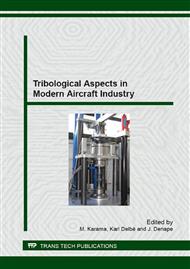p.1
p.13
p.21
p.29
p.35
p.43
Experimental Modeling of Wear Behavior of Filled Elastomer SBR under Dry Friction-Influence of Roughness
Abstract:
The wear behaviour of a filled styrene butadiene rubber (SBR) is investigated in this paper. The material contact used is plan /plan with a hard steel XC38. The influence of tribological parameters such as type contact (contact plan/plan under dry friction), relative motion between the contact surfaces (rotational disc/fixed elastomer sample), topography of the surface contact (roughness), loading (normal load or contact pressure), sliding friction and operating time or number of cycles is investigated. The highlighting of these parameters influence and analysis results permits us to formulate a wear model for the filled elastomer SBR. The model is based on the Archard law developed for metallic materials. The modification concerns the introduction of material parameters to take accounts the hyperelastic behaviour of elastomer due to the presence of amorphous phase. Particular interest is given to the influence of the surface state of the indenter given by the counterface arithmetic roughness Ra on the weight loss of the elastomer due to the wear phenomena. For a lower value (little to 6.3μm) of the arithmetic roughness, the weight loss is insignificant for different contact pressure and various sliding speeds. This effect is more noticeable at higher values of roughness and dependent on other tribological parameters. This results comfort other conclusion on the literature that express the influence of roughness by the geometric parameters of the micro-waves in the surface. The effects of the roughness can be explained by the ratio between the amplitude and wavelength of the corrugation. Indeed, we relate the roughness influence at the strain energy restored by material hyperelastic which also is, necessarily, a function of the velocity sliding and pressure contact.
Info:
Periodical:
Pages:
13-20
Citation:
Online since:
March 2015
Authors:
Keywords:
Price:
Сopyright:
© 2015 Trans Tech Publications Ltd. All Rights Reserved
Share:
Citation:


